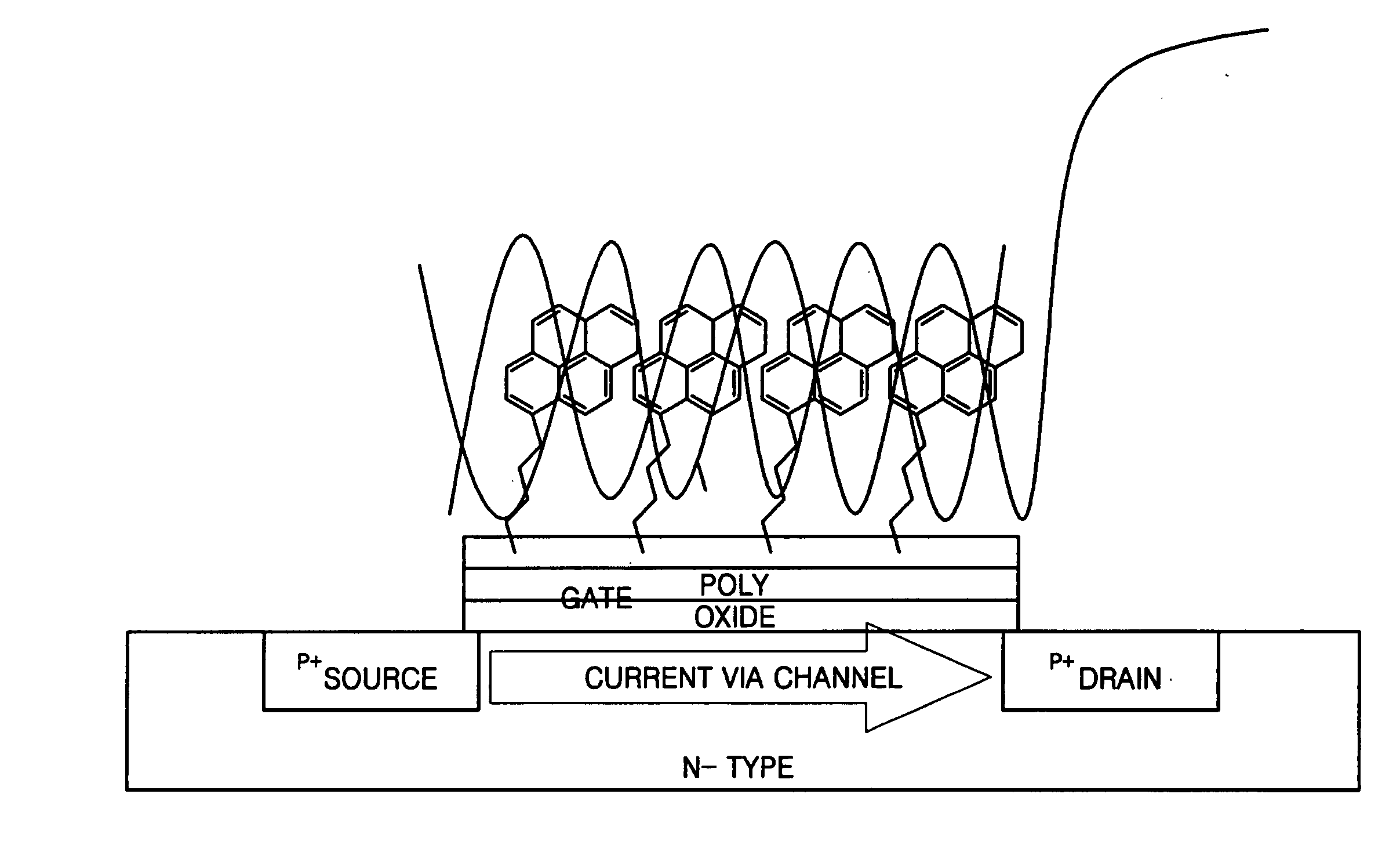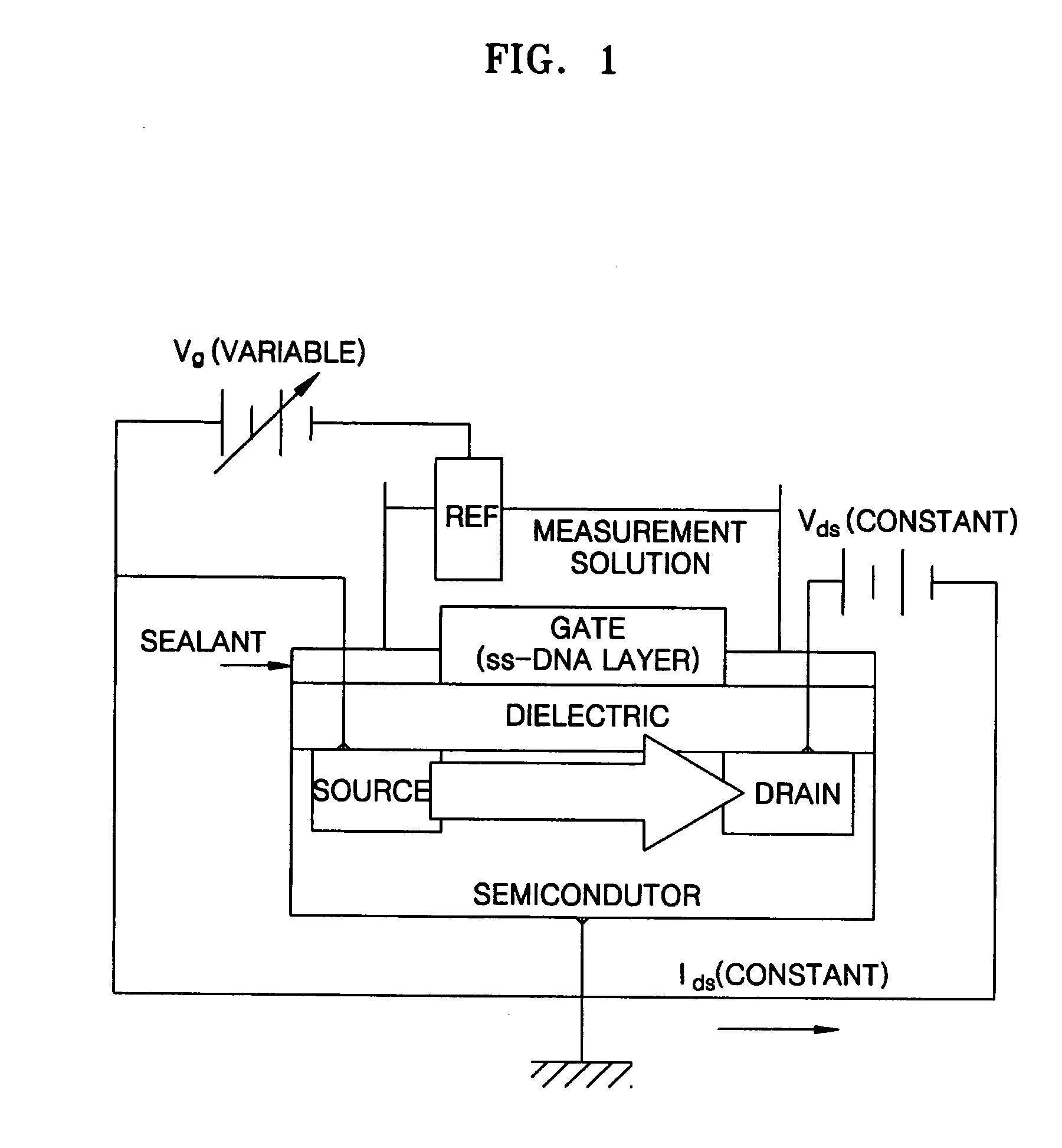FET-type biosensor with surface modification
a biosensor and surface technology, applied in biochemistry apparatus and processes, instruments, materials analysis, etc., can solve the problems of difficult to obtain effective depletion regions, long time required for fixing probes, and difficult to detect signals within debye length, etc., to achieve the effect of increasing sensitivity
- Summary
- Abstract
- Description
- Claims
- Application Information
AI Technical Summary
Benefits of technology
Problems solved by technology
Method used
Image
Examples
embodiment 1
[0043] In the present embodiment, a coupling agent such as GAPS was bound to a silicon substrate including a 1000 Å SiO2 layer, and an intercalator was added thereto. The addition of the intercalator was confirmed using a fluorescent scanner, and an oligonucleotide with a complementary sequence was hybridized and fixed to the substrate through the intercalator. Intercalation of the hybridized oligonucleotide was confirmed using a fluorescence scanner.
[0044] 1) Bonding Between Silicon Substrate and Coupling Agent (GAPS)
[0045] First, a substrate was cleaned before a surface treatment was performed. In the cleaning process, a pure acetone and water and then a piranha solution, which is formed by mixing a hydrogene peroxide and a sulfonic acid in a weight ratio of 1:3 were used to remove organic impurities. Then, the resulting substrate was cleaned using a large amount of water and acetone and then dried. In detail, the substrate cleaning process was performed using a wet station used...
embodiment 2
[0051] The change of an electric signal was observed by adding an intercalator to the surface of a gate of an FET device. In the present embodiment, N-Pyrene-2-aminoethanthiol (pyrenethiol) was synthesized and used to modified the surface of the gate. Pyrenethiol contains a thiol functional group and pyrene. Pyrenethiol can be fixed to the surface of the gate due to the functional group, and can also be intercalated with an oligonucleotide or DNA due to the pyrene. Any FET that is commercially used can be used in the present invention. However, in the present embodiment, the FET had a gate on which gold was deposited, which was manufactured by Samsung Semiconductor Inc.
[0052] 1) Washing of FET device
[0053] The FET device according to the present embodiment is different form a conventional FET device in that gold was deposited on the gate so that pyrenethiol could be added to the surface of the gate using Au—S bonding. First, organic impurities in the FET device were removed using ...
embodiment 3
[0056] In the present embodiment, the surface of a gate of an FET device was modified with an intercalator to locate DNA very closed to the surface of the gate thus inducing a substantial change of a signal. Pyrenethiol was used to modify the surface of the gate. In order to observe the change of the electrical signal due to the binding of an oligonucleotide, a complementary pair of oligonucleotides and a non-complementary pair of oligonucleotides were used.
[0057] 1) Addition of Intercalator to FET Device
[0058] The intecalator was added to the gate of the FET device. Since the FET device included a gate treated with gold, which is difference from a conventional FET, the intercalator could be added to the surface of the gate through Au—S bonding. First, First, organic impurities in the FET device were removed using a piranha solution formed by mixing hydrogen peroxide and sulfonic acid in a weight ratio of 1:3. Then, the resulting FET device was washed with a large amount of water ...
PUM
 Login to View More
Login to View More Abstract
Description
Claims
Application Information
 Login to View More
Login to View More - R&D
- Intellectual Property
- Life Sciences
- Materials
- Tech Scout
- Unparalleled Data Quality
- Higher Quality Content
- 60% Fewer Hallucinations
Browse by: Latest US Patents, China's latest patents, Technical Efficacy Thesaurus, Application Domain, Technology Topic, Popular Technical Reports.
© 2025 PatSnap. All rights reserved.Legal|Privacy policy|Modern Slavery Act Transparency Statement|Sitemap|About US| Contact US: help@patsnap.com



